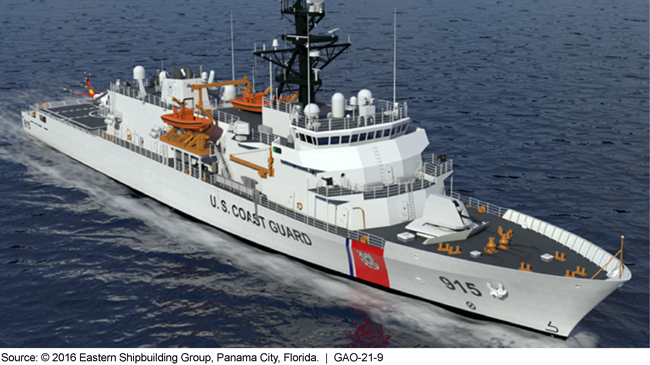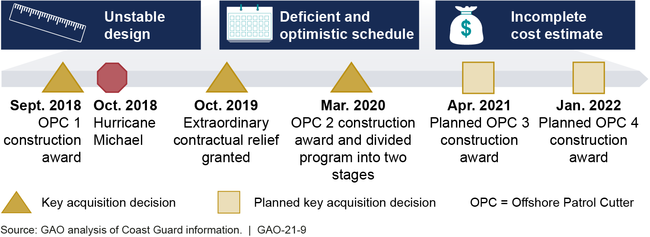Coast Guard Acquisitions: Opportunities Exist to Reduce Risk for the Offshore Patrol Cutter Program
Fast Facts
In 2018, Hurricane Michael devastated the shipyard where construction of the Coast Guard's Offshore Patrol Cutters was about to begin. The service needs the 25 new cutters soon to replace others that are more than 50 years old, but the hurricane added delays and cost.
The Coast Guard accepted significant risk with the design, schedule, and cost—both before and after the hurricane—to get the cutters built quickly. But the cutter's design is unstable, its schedule optimistic, and its cost estimate incomplete—making it likely that building it will take longer and cost more.
Our 8 recommendations could help set the program on a better path.
Rendering of the Coast Guard's Offshore Patrol Cutter

Highlights
What GAO Found
The Coast Guard divided the Offshore Patrol Cutter (OPC) program into two stages and revised its cost and schedule goals following widespread disruptions from Hurricane Michael in October 2018, which led the shipbuilder to request relief from certain requirements under contract. Under this revised plan, the current shipbuilder will build up to four OPCs in the first stage, while the acquisition of the remaining 21 OPCs will be awarded under one or more new contracts starting in fiscal year 2022 in the second stage.
The Coast Guard's determination to deliver the OPCs in a timely manner has driven the program through key acquisition decisions despite significant design, testing, schedule, and cost risks, which remained or were exacerbated after the hurricane (see figure).
Offshore Patrol Cutter Program Moved Forward Despite Major Risks

Unstable Design. The Coast Guard authorized the start of construction for the first two OPCs despite not having a stable design, which is inconsistent with shipbuilding best practices. Proceeding towards OPC 3 construction before stabilizing the design—including maturing the design drawings of major ship systems—increases the risk of construction rework if changes are needed. This could further delay schedules and increase costs.
Deficient and Optimistic Schedule. Prior to the construction award for OPC 1, the OPC program's schedule has contained significant deficiencies that are contrary to what is called for in best practices for developing schedules that GAO identified. Further, the revised post-hurricane delivery dates for the first four OPCs are optimistic and do not fully incorporate schedule risks, increasing the likelihood that the OPCs will not be delivered when promised.
Incomplete Cost Estimate. The cost estimate used to inform the program's new cost goals did not include key analyses called for in best practices for developing cost estimates GAO identified. These key analyses include varying assumptions to determine how sensitive the estimates are to various factors and quantifying the effects of potential risks. Omitting these analyses undermines the credibility of the estimated program costs, increasing the risk that decision makers do not have a complete picture of the full range of costs the program could incur.
Why GAO Did This Study
The Coast Guard—a component of the Department of Homeland Security (DHS)—is planning to spend over $12 billion to acquire a fleet of 25 OPCs. This is the component's highest investment priority and will help ensure a variety of missions, such as drug and migrant interdiction, are carried out in offshore waters once its aging Medium Endurance Cutters are decommissioned. After Hurricane Michael—a category 5 storm—significantly disrupted the OPC shipbuilder's ability to continue work in October 2018, DHS granted up to $659 million in extraordinary contractual relief to the shipbuilder.
GAO was asked to review the status of the OPC acquisition program. This report examines, among other objectives, how the Coast Guard revised the OPC program after Hurricane Michael and the extent to which the program addressed major risks—particularly in the areas of design maturity, schedule, and cost— before proceeding through key acquisition decisions both pre- and post-hurricane. GAO reviewed Coast Guard program and contract documents, analyzed Coast Guard data, and interviewed Coast Guard and DHS officials.
Recommendations
GAO is making eight recommendations to the Coast Guard and DHS, including ensuring that the program stabilizes its design before proceeding with construction of the next OPC, updates its schedule to address deficiencies and incorporate risks, and updates its cost estimate to improve its credibility.
Recommendations for Executive Action
| Agency Affected | Recommendation | Status |
|---|---|---|
| Department of Homeland Security | The DHS Secretary should ensure the DHS Under Secretary for Management directs the Coast Guard to revise OPC's acquisition program baseline for stage 1 to include OPC's delivery dates. (Recommendation 1) |
DHS concurred with our recommendation. In August 2024, DHS leadership approved a revised acquisition program baseline for the OPC program, which included delivery dates for the first ship (OPC 1) and last ship (OPC 4) on the stage 1 contract. This revision meets the intent of our recommendation
|
| Department of Homeland Security | The DHS Secretary should ensure the DHS Under Secretary for Management directs the Coast Guard to include in OPC's acquisition program baseline for stage 2 OPC's delivery dates when the stage 2 acquisition program baseline is established and approved at ADE 2B. (Recommendation 2) |
DHS concurred with our recommendation. In August 2024, DHS leadership approved a revised acquisition program baseline for the OPC program, which split planned stage 2 ships OPCs 5-25 into two stages. The baseline now defines stage 2 as OPCs 5-15 and stage 3 as OPCs 16-25. While the revised baseline includes delivery dates for OPCs 5 and 25, this no longer meets the intent of our recommendation which was to include goals for DHS to hold the program accountable for at least the first and last ship delivery for each stage. To address our recommendation, we would expect to see the program add delivery dates to its acquisition program baseline for OPCs 5 and 15, as well as OPC 16 and 25 once stage 3 is underway.
|
| United States Coast Guard | The Commandant of the Coast Guard should ensure the OPC program demonstrates that the OPC design for stage 1 is stable prior to approval of construction start for OPC 3 by (1) completing ESG's basic and functional designs and (2) maturing the davit technology to a TRL of 7, consistent with shipbuilding best practices. (Recommendation 3) |
DHS concurred with our recommendation. However, in April 2021, the Coast Guard authorized construction on OPC 3 prior to completing the functional design and maturing the davit technology to a TRL of 7.
|
| United States Coast Guard | The Commandant of the Coast Guard should ensure the Coast Guard Component Acquisition Executive revises Coast Guard's acquisition policy to include criteria and a methodology for demonstrating design maturity for shipbuilding programs that are aligned with shipbuilding best practices, including specifying the completion of basic and functional designs and maturing critical technologies to a TRL of 7. (Recommendation 4) |
DHS concurred with our recommendation. In August 2022, the Coast Guard issued a standard operating procedure related to design maturity but did not specify full completion of the basic and functional designs or maturation of critical technology to a TRL 7. In May 2023, the Coast Guard revised its standard operating procedure to specify that critical technologies should be matured to a TRL of 7 prior to starting construction. However, this is not aligned with shipbuilding leading practices which call for critical technologies to be matured to a TRL 7 before the award of the contract for lead ship design. Additionally, the Coast Guard's revised guidance did not specify that programs needed to complete basic and functional design prior to starting construction as called for by shipbuilding leading practices. As of May 2025, the Coast Guard had not updated its policy to further align with shipbuilding leading practices.
|
| Department of Homeland Security | The DHS Secretary should ensure the DHS Under Secretary for Management directs the Coast Guard, prior to approval of construction start for OPC 3, to identify the associated cost, schedule, and operational risks of the program's testing strategy for stage 1; and document these analyses in an updated test and evaluation master plan. (Recommendation 5) |
DHS concurred with our recommendation. In April 2021, the Coast Guard revised the OPC test and evaluation master plan to align with changes in the program's acquisition strategy and schedule and identified the associated cost, schedule, and operational risks with the program's test activities for stage 1.
|
| United States Coast Guard | The Commandant of the Coast Guard should ensure the OPC program updates its shipbuilder and government schedules for OPCs 1 through 4 to (1) fully address deficiencies identified in the shipbuilder's schedule, and (2) fully incorporate schedule risk analysis in accordance with schedule best practices. (Recommendation 6) |
DHS concurred with our recommendation. The shipbuilder updated its schedules for OPCs 1-3 in January 2022 and completed the schedule for OPC 4 in October 2022. However, the Coast Guard and the Defense Contract Management Agency identified that these schedules continued to contain deficiencies and risks that are inconsistent with schedule best practices. In July 2023, the shipbuilder began reviewing its schedules for OPCs 1-4 after notifying the Coast Guard that it could not meet its revised contract delivery dates. In August 2024, DHS leadership approved a revised acquisition program baseline for the OPC program despite the shipbuilder only completing its review of the schedule for OPC 1. Therefore, the government's revised schedule does not reflect the current status of stage 1. As of May 2025, the Coast Guard was continuing to review ESG's updated schedules for OPCs 2-4.
|
| Department of Homeland Security | The DHS Secretary should ensure the DHS Under Secretary for Management directs the Coast Guard, as it develops the next life cycle cost estimate for the OPC program, to update its cost estimate for stage 1 in accordance with best practices for cost estimation, including: (1) conducting a sensitivity analysis, (2) conducting a risk and uncertainty analysis, (3) reflecting information from the program's most recent technical baseline, and (4) conducting an independent cost assessment of the estimate. (Recommendation 7) |
DHS concurred with our recommendation. The Navy assisted the Coast Guard with completing a full life cycle cost estimate revision for the OPC program in 2023, which DHS leadership approved in July 2024. The 2023 cost estimate was consistent with the program's updated technical baseline and the Navy performed analyses to assess risk and uncertainty, as well as the sensitivity of the estimate to various factors, such as the cost of labor and materials. Additionally, DHS's Cost Analysis Division conducted an independent cost assessment in April 2024 and determined the estimate was comprehensive and credible.
|
| United States Coast Guard | The Commandant of the Coast Guard should ensure the OPC program improves its risk management processes to follow the format and include content as indicated in DHS acquisition policy and Coast Guard guidance, including (1) holding monthly risk management board meetings and updating its risk register regularly; (2) revising the risk register to include the risks we identified in this report—proceeding into construction with an incomplete 3D model, conducting late operational testing, challenges with ESG's scheduling practices, and challenges with ESG's accounting system; and (3) revising the risk register to comprehensively track risk management information. (Recommendation 8) |
DHS concurred with our recommendation. In October 2020, the Coast Guard improved the OPC program's risk management processes to follow the format and include content as indicated in the DHS acquisition policy and Coast Guard guidance. This included updates to the OPC program's risk and opportunities management plan and regularly holding meetings to monitor risk. Additionally, the Coast Guard updated its risk register to capture the specific risks we identified in this report and to include supporting information such as mitigation plans to ensure risks are being comprehensively tracked.
|
